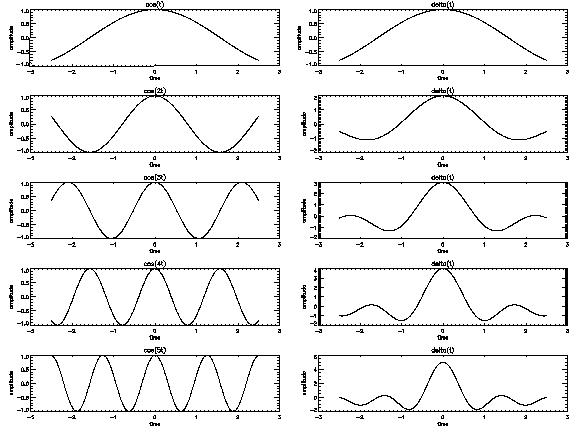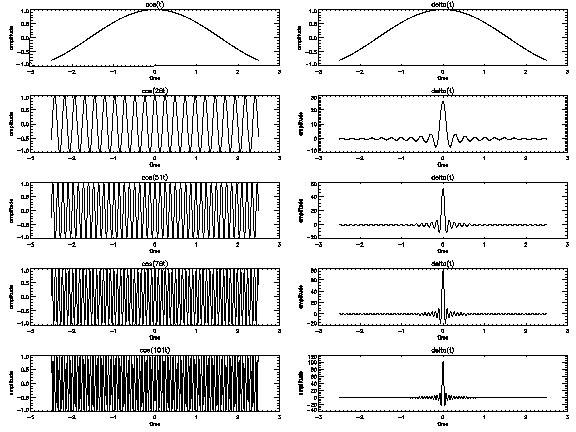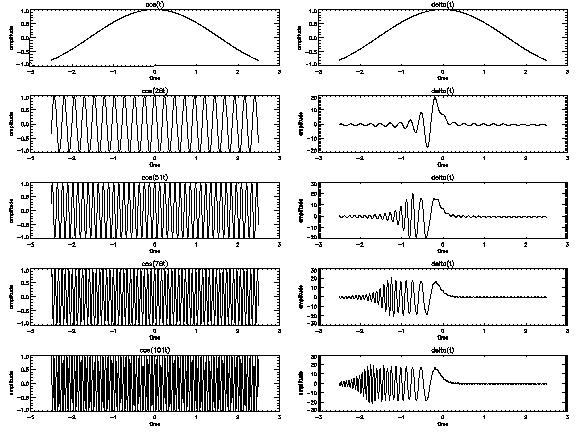“Astropulse:啁啾脉冲”的版本间差异
跳转到导航
跳转到搜索
| 第1行: | 第1行: | ||
| − | <big>'''Chirped pulses'''</big> | + | <big>'''Chirped pulses'''</big><br> |
| + | <big>'''啁啾信号'''</big> | ||
| − | 1. | + | 1. 一个短脉冲实际上是由许多分布在不同频率的窄带信号所合成的。下图展示的是由四个窄带信号依次叠加以形成一个短脉冲的过程。这里的“窄带”表示的是信号的持续时间长而且呈波浪状,看上去就像一个正弦函数,对应下图中左边的那几个信号。四个窄带信号的合成结果显示在下图右边。X 轴表示时间,Y 轴表示脉冲的幅度。(对于水波来说,幅度就是波纹的高度,对于声波,幅度表示的是气压,对于电磁波,幅度表示的是电场或磁场的强度。)请特别注意下图最右下角的那幅子图!那是所有四个原始信号的叠加结果,它已经看上去像是一个短脉冲了,而不再是呈波浪状。 |
[[Image:Delta_from_4.jpg]] | [[Image:Delta_from_4.jpg]] | ||
| − | 2. | + | 2. 图 2 和图 1 类似,只不过我们这回是把 100 个窄带信号叠加起来。下图中右边的四幅子图依次表示叠加了 25 个、50 个、75 个以及 100 个信号后的结果。现在最右下角的那个波形已经是一个非常短的脉冲啦。 |
[[Image:Delta_from_100.jpg]] | [[Image:Delta_from_100.jpg]] | ||
| − | 3. | + | 3. 最后,让我们来对信号进行色散处理。这意味着较高频率的信号(也就是单位时间内容有更多波峰的信号)会更早地到达,而较低频率的信号会来得更晚些。最终得到的结果就是一个“啁啾”信号。 |
[[Image:Chirp_from_100.jpg]] | [[Image:Chirp_from_100.jpg]] | ||
| − | Astropulse | + | Astropulse 接收的信号就类似于上图 3 中的信号。它必须得先对信号进行“消色散”处理才能得到左边的那些窄带信号,然后还需要经过重新定位,信号才会看上去像图 2 中的短脉冲。 |
| − | [[Category:Astropulse | + | [[Category:Astropulse]] |
2010年7月24日 (六) 17:05的版本
Chirped pulses
啁啾信号
1. 一个短脉冲实际上是由许多分布在不同频率的窄带信号所合成的。下图展示的是由四个窄带信号依次叠加以形成一个短脉冲的过程。这里的“窄带”表示的是信号的持续时间长而且呈波浪状,看上去就像一个正弦函数,对应下图中左边的那几个信号。四个窄带信号的合成结果显示在下图右边。X 轴表示时间,Y 轴表示脉冲的幅度。(对于水波来说,幅度就是波纹的高度,对于声波,幅度表示的是气压,对于电磁波,幅度表示的是电场或磁场的强度。)请特别注意下图最右下角的那幅子图!那是所有四个原始信号的叠加结果,它已经看上去像是一个短脉冲了,而不再是呈波浪状。
2. 图 2 和图 1 类似,只不过我们这回是把 100 个窄带信号叠加起来。下图中右边的四幅子图依次表示叠加了 25 个、50 个、75 个以及 100 个信号后的结果。现在最右下角的那个波形已经是一个非常短的脉冲啦。
3. 最后,让我们来对信号进行色散处理。这意味着较高频率的信号(也就是单位时间内容有更多波峰的信号)会更早地到达,而较低频率的信号会来得更晚些。最终得到的结果就是一个“啁啾”信号。
Astropulse 接收的信号就类似于上图 3 中的信号。它必须得先对信号进行“消色散”处理才能得到左边的那些窄带信号,然后还需要经过重新定位,信号才会看上去像图 2 中的短脉冲。


